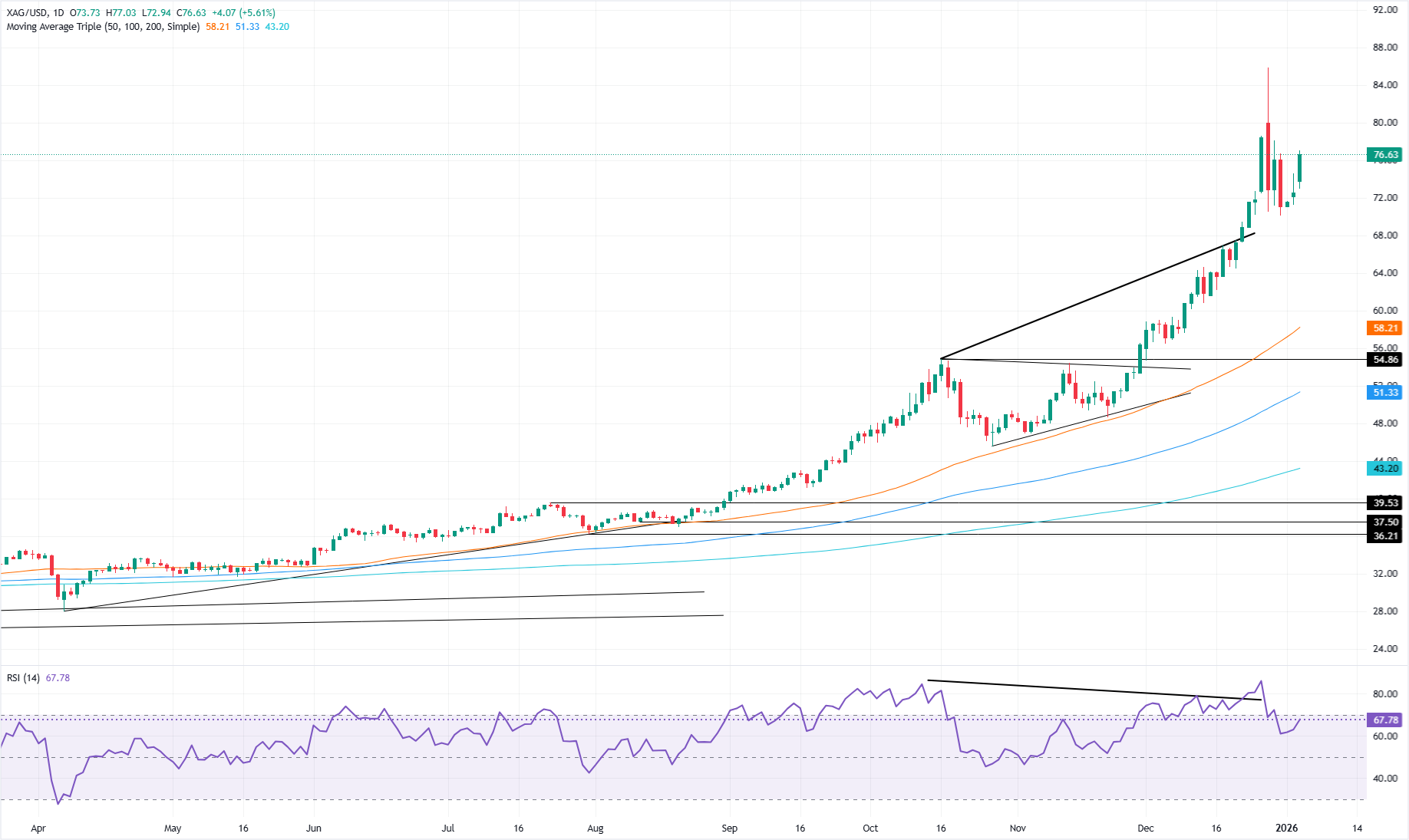Forex News

- EUR/USD stages a rebound after weak US ISM Manufacturing PMI data weighs on the Dollar.
- Policy divergence between the Fed and ECB continues to favour the Euro.
- Focus turns to upcoming US and Eurozone data releases, with attention on Nonfarm Payrolls.
The Euro (EUR) trims part of its earlier losses against the US Dollar (USD) on Monday after weaker-than-expected US ISM Manufacturing Purchasing Managers Index (PMI) data weighs on the Greenback. At the time of writing, EUR/USD trades around 1.1706, rebounding from an intraday low near 1.1659.
The ISM Manufacturing PMI remained in contraction territory in December at 47.9, below the market forecast of 48.3 and edging lower from November’s 48.2 reading. The ISM Manufacturing Prices Paid Index stood at 58.5, unchanged from last month and below expectations of 59.0.
Within the report, the ISM Manufacturing Employment Index rose to 44.9 in December from 44.0 in November, remaining in contraction territory. The New Orders Index contracted for a fourth straight month in December after one month of growth, edging up to 47.7 from 47.4.
The weaker survey results weighed on the US Dollar, trimming its earlier gains after an initial advance driven by safe-haven demand. The Greenback had found early support following the US military operation in Venezuela over the weekend, which led to the capture of Venezuelan President Nicolas Maduro.
On the monetary policy front, diverging outlooks between the Federal Reserve (Fed) and the European Central Bank (ECB) keep EUR/USD tilted to the upside. Markets continue to expect the Fed to remain on an easing path, with investors pricing in two interest rate cuts in 2026. In contrast, the ECB is seen holding rates steady amid resilient growth and inflation near target.
Looking ahead, traders turn their attention to a busy economic calendar on both sides of the Atlantic. In the United States, S&P Global Composite and Services PMIs are due on Tuesday, followed by the ADP Employment Change, the ISM Services PMI, and the JOLTS Job Openings report on Wednesday. Weekly Initial Jobless Claims are scheduled for Thursday, ahead of the closely watched Nonfarm Payrolls (NFP) report on Friday.
In the Eurozone, HCOB Composite and Services PMIs are released on Tuesday, with the preliminary Core Harmonized Index of Consumer Prices (HICP) due on Wednesday. On Thursday, focus turns to Consumer Confidence, the Unemployment Rate, the Economic Sentiment Indicator, and the Producer Price Index (PPI).
US Dollar FAQs
The US Dollar (USD) is the official currency of the United States of America, and the ‘de facto’ currency of a significant number of other countries where it is found in circulation alongside local notes. It is the most heavily traded currency in the world, accounting for over 88% of all global foreign exchange turnover, or an average of $6.6 trillion in transactions per day, according to data from 2022. Following the second world war, the USD took over from the British Pound as the world’s reserve currency. For most of its history, the US Dollar was backed by Gold, until the Bretton Woods Agreement in 1971 when the Gold Standard went away.
The most important single factor impacting on the value of the US Dollar is monetary policy, which is shaped by the Federal Reserve (Fed). The Fed has two mandates: to achieve price stability (control inflation) and foster full employment. Its primary tool to achieve these two goals is by adjusting interest rates. When prices are rising too quickly and inflation is above the Fed’s 2% target, the Fed will raise rates, which helps the USD value. When inflation falls below 2% or the Unemployment Rate is too high, the Fed may lower interest rates, which weighs on the Greenback.
In extreme situations, the Federal Reserve can also print more Dollars and enact quantitative easing (QE). QE is the process by which the Fed substantially increases the flow of credit in a stuck financial system. It is a non-standard policy measure used when credit has dried up because banks will not lend to each other (out of the fear of counterparty default). It is a last resort when simply lowering interest rates is unlikely to achieve the necessary result. It was the Fed’s weapon of choice to combat the credit crunch that occurred during the Great Financial Crisis in 2008. It involves the Fed printing more Dollars and using them to buy US government bonds predominantly from financial institutions. QE usually leads to a weaker US Dollar.
Quantitative tightening (QT) is the reverse process whereby the Federal Reserve stops buying bonds from financial institutions and does not reinvest the principal from the bonds it holds maturing in new purchases. It is usually positive for the US Dollar.

The Canadian Dollar (CAD) has largely followed broader US Dollar (USD) trends through the holiday period, with limited domestic catalysts so far. However, technical signals now suggest the USD rebound may be losing momentum, leaving room for CAD gains if upcoming Canadian data—especially Friday’s employment report—confirms relative economic resilience, Scotiabank's Chief FX Strategists Shaun Osborne and Eric Theoret report.
USD/CAD rally shows signs of stalling near key resistance
"The CAD has been tracking the broader trend in the USD over the holiday period and intraday moves are extending that trend to a large extent. CAD-specific news and developments over the holiday period have been very limited (the Dec S&P Global Manufacturing PMI firmed modestly to a still soft 48.6). Canadian data releases pick up in the next few days and include PMIs, trade and jobs data."
"The CAD was able to leverage better than expected economic data to advance against the USD late last year and will be looking to pick up a bit more ground again if the trend in data—especially Friday’s employment report—continues to show (relative) strength. Intraday price action suggests the USD’s rebound from the Dec 26th low may be stalling."
"A 'hammer' low/reversal signal marked the late Dec base for the USD and intraday patterns so far today reflect the opposite—a 'hanging man' pattern on the candle chart. A lot may change between now and the end of the trading day, of course but the USD likely needs to push above 1.3810 to signal an extension of its New Year rally in the short run. USD support is 1.3750 and 1.3725."

The US Dollar (USD) has edged back toward its pre-Christmas highs, supported by a modest safe-haven bid following dramatic developments in Venezuela. However, momentum appears to be stalling as Asian currencies strengthen, broader markets remain calm, and investor focus shifts toward a busy week of top-tier US economic data, Scotiabank's Chief FX Strategists Shaun Osborne and Eric Theoret report.
Venezuela shock lifts haven demand
"The USD has spent the past week grinding back towards the peaks seen just before the Christmas period, with weekend’s extraordinary developments in Venezuela giving the dollar an added boost from uncertainty/haven demand. Just how much of a lift geo-politics can give the USD remains to be seen; the DXY is already showing some signs of faltering a little above the peaks seen on December 19th and there is a fair amount to top-tier US data this week that will certainly attract more attention from traders and investors and as volumes pick up after the holidays."
"Most attention is on geopolitics this morning but creeping gains for Asian FX may act as a restraint on USD gains in the short run and might be more meaningful for the broader USD direction in the medium term. The JPY is outperforming on the session at the margin which gives a little more credence to the 'safe haven' tone of FX trading at least but gains may also reflect the general strength of Asia FX, pulled along by gains in the CNY through the 7.00 level to its highest in 2 1/2 years."
"US intentions as far as Venezuela are concerned are opaque at this point but its resource wealth is well-known. Broader market reaction is somewhat blasé. Stocks are mostly higher, bonds are a little firmer, with Gilts outperforming marginally, while crude oil is little changed. Gold is firmer. The impact of Maduro’s capture may fade unless the situation deteriorates significantly in the coming days."

- AUD/USD trades slightly higher after disappointing US ISM Manufacturing PMI data.
- Rising geopolitical tensions boost safe-haven demand in favor of the US Dollar.
- Expectations around Australian inflation and RBA policy remain a potential support.
AUD/USD trades around 0.6700 on Monday, up 0.10% on the day, after erasing previous intraday losses following the release of the US Purchasing Managers Index (PMI) data. The Australian Dollar (AUD) shows resilience despite an uncertain macroeconomic backdrop.
Sentiment around the Australian Dollar is influenced by the latest Chinese statistics. China’s RatingDog Services PMI slipped to 52.0 in December from 52.1 in November, pointing to a slight slowdown in activity in the services sector. At the same time, RatingDog reported last week that the Manufacturing PMI edged up to 50.1 in December from 49.9 previously, moving marginally back into expansion territory. Any change in the Chinese economy remains crucial for the Australian Dollar, as China is Australia’s main trading partner.
On the domestic front, expectations of monetary tightening continue to provide underlying support to the Aussie. Market participants are turning their attention to Australia’s fourth-quarter Consumer Price Index (CPI), due on January 28. Several analysts believe that a stronger-than-expected core inflation reading could prompt the Reserve Bank of Australia (RBA) to raise interest rates at its February 3 meeting. RBA Governor Michele Bullock recently noted that while the board did not explicitly consider an immediate rate hike, it did discuss the conditions under which monetary policy might need to be tightened.
On the US side, the US Dollar (USD) was supported earlier in the day by safe-haven demand amid heightened geopolitical tensions in Latin America. The Greenback benefited from developments surrounding Venezuela, after the United States (US) captured President Nicolas Maduro, an event that has revived geopolitical concerns and strengthened the US Dollar.
However, the USD trend reverted after the release of the US Institute for Supply Management (ISM) Manufacturing PMI. The index fell for a third consecutive month to 47.9 in December, down from 48.2 in November and below market expectations of 48.3. The reading signals a faster contraction in US manufacturing activity, driven mainly by declines in production and inventories, while price pressures remain elevated. Although some components, such as New Orders and Export Orders, showed marginal improvement, the overall data reinforce signs of a cooling industrial sector, adding nuance to the outlook for US growth and monetary policy expectations.
Markets continue to price in two additional Federal Reserve (Fed) rate cuts in 2026. Investors also remain attentive to the prospect of US President Donald Trump nominating a new Fed Chair when Jerome Powell’s term ends in May, a move seen as potentially tilting monetary policy toward a more accommodative stance. Minutes from the December Federal Open Market Committee (FOMC) meeting showed that several officials judged it would be appropriate to pause further rate cuts as long as inflation continues to ease gradually.
Australian Dollar Price Today
The table below shows the percentage change of Australian Dollar (AUD) against listed major currencies today. Australian Dollar was the strongest against the Canadian Dollar.
| USD | EUR | GBP | JPY | CAD | AUD | NZD | CHF | |
|---|---|---|---|---|---|---|---|---|
| USD | 0.17% | -0.27% | -0.23% | 0.20% | -0.16% | -0.23% | 0.18% | |
| EUR | -0.17% | -0.41% | -0.33% | 0.03% | -0.33% | -0.38% | 0.01% | |
| GBP | 0.27% | 0.41% | 0.06% | 0.48% | 0.11% | 0.05% | 0.46% | |
| JPY | 0.23% | 0.33% | -0.06% | 0.42% | 0.05% | -0.01% | 0.40% | |
| CAD | -0.20% | -0.03% | -0.48% | -0.42% | -0.36% | -0.42% | -0.02% | |
| AUD | 0.16% | 0.33% | -0.11% | -0.05% | 0.36% | -0.05% | 0.34% | |
| NZD | 0.23% | 0.38% | -0.05% | 0.00% | 0.42% | 0.05% | 0.40% | |
| CHF | -0.18% | -0.01% | -0.46% | -0.40% | 0.02% | -0.34% | -0.40% |
The heat map shows percentage changes of major currencies against each other. The base currency is picked from the left column, while the quote currency is picked from the top row. For example, if you pick the Australian Dollar from the left column and move along the horizontal line to the US Dollar, the percentage change displayed in the box will represent AUD (base)/USD (quote).

- Silver spikes close to $76 as Venezuela leadership upheaval fuels demand for hard-asset hedges.
- Trump’s comments on military escalation lift geopolitical risk, supporting precious metals despite a firmer US Dollar.
- Weak US ISM Manufacturing PMI adds macro uncertainty ahead of NFPs and key US data.
Silver extends its rally on Monday, registering stellar gains of more than 4% following geopolitical events over the weekend, which featured the ousting of the President of Venezuela Nicolas Maduro, captured by US elite forces on Saturday. At the time of writing, XAG/USD trades at $75.91 a troy ounce.
XAG/USD surges over 4% on geopolitical turmoil, despite strong US Dollar
Market sentiment is mixed. Precious metals are rising, as are stocks, as seen by US equity markets rising between 0.24% and 0.89%. In the FX space, the King Dollar is back, up 0.22%, a headwind for most G10 FX currencies.
Nevertheless, precious metals could extend their advance, amid uncertainty following US President Donald Trump's comments that the US will "run" Venezuela. Furthermore, he added that if the current government, led by Vice-President Delcy Rodriguez, does not cooperate with the US, they could repeat the operation.
When asked, Trump said that military action could extend to Colombia and Mexico if they do not reduce the flow of drugs.
As of writing, the US ISM Manufacturing PMI for December 2025 missed estimates of 48.3, coming in at 47.9, indicating deterioration in the manufacturing sector.
Ahead, the US economic docket will feature the ISM Services PMI, Initial Jobless Claims for the week ending January 3 and December’s Nonfarm Payrolls.
XAG/USD Price Analysis: Technical outlook
Silver uptrend remains intact, yet it seems overextended after reaching three-day highs and momentum shows signs of waning. The Relative Strength Index (RSI), although bullish, has failed to clear its latest peak. This means that the potential for a pullback looms.
Nevertheless, XAG/USD path of least resistance is upwards. The next key resistance is the December 30 high at $78.06, followed by the $79.00 figure and $80.00. On the flip side, if Silver tumbles below $75.00, the next immediate demand level would be the January 2 high turned support at $74.55 ahead of $74.00 per troy ounce.

Silver FAQs
Silver is a precious metal highly traded among investors. It has been historically used as a store of value and a medium of exchange. Although less popular than Gold, traders may turn to Silver to diversify their investment portfolio, for its intrinsic value or as a potential hedge during high-inflation periods. Investors can buy physical Silver, in coins or in bars, or trade it through vehicles such as Exchange Traded Funds, which track its price on international markets.
Silver prices can move due to a wide range of factors. Geopolitical instability or fears of a deep recession can make Silver price escalate due to its safe-haven status, although to a lesser extent than Gold's. As a yieldless asset, Silver tends to rise with lower interest rates. Its moves also depend on how the US Dollar (USD) behaves as the asset is priced in dollars (XAG/USD). A strong Dollar tends to keep the price of Silver at bay, whereas a weaker Dollar is likely to propel prices up. Other factors such as investment demand, mining supply – Silver is much more abundant than Gold – and recycling rates can also affect prices.
Silver is widely used in industry, particularly in sectors such as electronics or solar energy, as it has one of the highest electric conductivity of all metals – more than Copper and Gold. A surge in demand can increase prices, while a decline tends to lower them. Dynamics in the US, Chinese and Indian economies can also contribute to price swings: for the US and particularly China, their big industrial sectors use Silver in various processes; in India, consumers’ demand for the precious metal for jewellery also plays a key role in setting prices.
Silver prices tend to follow Gold's moves. When Gold prices rise, Silver typically follows suit, as their status as safe-haven assets is similar. The Gold/Silver ratio, which shows the number of ounces of Silver needed to equal the value of one ounce of Gold, may help to determine the relative valuation between both metals. Some investors may consider a high ratio as an indicator that Silver is undervalued, or Gold is overvalued. On the contrary, a low ratio might suggest that Gold is undervalued relative to Silver.

- Gold trades above the $4,400 mark as US-Venezuela tensions fuel safe-haven demand.
- Investors remain focused on geopolitical risks and Fed expectations as key US data looms.
- Technically, XAU/USD holds a bullish bias after finding support near $4,300.
Gold (XAU/USD) trades with a bullish bias at the start of the first full trading week of 2026, as heightened tensions between the United States (US) and Venezuela drive fresh safe-haven demand. At the time of writing, XAU/USD trades around $4,448, up nearly 2.70% on the day.
Over the weekend, the US launched a major military operation in Venezuela, carrying out air and ground strikes that led to the capture of Venezuelan President Nicolas Maduro and his wife, Cilia Flores. US President Donald Trump said the US would temporarily “run” Venezuela. “We’re going to run the country until such time as we can do a safe, proper and judicious transition,” Trump told reporters.
Further supporting prices, the US Dollar gave up earlier gains after weak ISM data. Figures released earlier on Monday showed the ISM Manufacturing Purchasing Managers Index (PMI) remained in contraction territory in December at 47.9, below the market forecast of 48.3 and November’s 48.2 reading.
The sharp escalation between the US and Venezuela, combined with the ongoing Russia-Ukraine conflict, keeps Gold supported close to record highs near $4,549 set on December 26. Meanwhile, expectations of further monetary policy easing by the Federal Reserve (Fed) add an additional layer of support.
Looking ahead, the S&P Global Composite and Services PMIs will be released on Tuesday. Markets will also digest the ISM Services PMI and JOLTS Job Openings report on Wednesday, weekly Initial Jobless Claims on Thursday, and the closely watched Nonfarm Payrolls (NFP) report on Friday.
Market movers: Geopolitical uncertainty and Fed guidance remain in focus
- Venezuelan President Nicolás Maduro is being held at a detention center in Brooklyn to face drug- and terrorism-related charges. The move has drawn international criticism. However, the US president defended the action and issued sharp warnings to other countries in the region, saying Cuba looks ready to fall amid its economic troubles and that Mexico must get its act together on cartel violence. He also repeated controversial remarks about the strategic importance of Greenland.
- On the monetary policy front, investors are pricing in two interest rate cuts this year following a cumulative 75 basis points (bps) of easing in 2025. However, the Fed’s latest dot plot from the December FOMC meeting points to only one cut in 2026. Recent data showed the US economy expanded at an annualised pace of 4.3% in Q3, while inflation showed some signs of cooling, with the Consumer Price Index (CPI) rising 2.7% YoY in November, keeping the door open for further policy easing.
- Philadelphia Fed President Anna Paulson said over the weekend that she expects inflation to moderate, the labour market to stabilise and US economic growth to come in around 2% this year. Speaking ahead of the Allied Social Science Associations Annual Meeting, Paulson noted that the job market has been bending but not breaking. She said she views the current level of the funds rate as still a little restrictive, adding that some modest further policy adjustments could be appropriate later in the year.
- According to the CME FedWatch Tool, markets widely expect the Fed to keep interest rates unchanged at the January 27-28 meeting, with only an 18.3% probability of a rate cut. The odds of a cut rise to around 44% for the March meeting.
Technical analysis: Buyers regain control after shallow correction

The technical outlook for XAU/USD remains bullish following a brief correction from record highs, with buyers stepping back in near the $4,300 psychological level.
On the 4-hour chart, the Relative Strength Index has turned higher and climbed back above the 50 threshold after briefly dipping toward oversold territory, pointing to improving momentum. However, the Average Directional Index continues to trend lower, indicating a loss of trend strength and suggesting prices may consolidate before the next leg higher.
On the upside, immediate resistance is seen near $4,450. A sustained break above this zone would expose the all-time high around $4,549, with further upside potential beyond that level.
On the downside, a failure to hold above the 50-period Simple Moving Average (SMA) near $4,420 would shift focus toward the 100-period SMA around $4,367. Stronger support is located near the $4,300 psychological mark, where buyers previously emerged.
Gold FAQs
Gold has played a key role in human’s history as it has been widely used as a store of value and medium of exchange. Currently, apart from its shine and usage for jewelry, the precious metal is widely seen as a safe-haven asset, meaning that it is considered a good investment during turbulent times. Gold is also widely seen as a hedge against inflation and against depreciating currencies as it doesn’t rely on any specific issuer or government.
Central banks are the biggest Gold holders. In their aim to support their currencies in turbulent times, central banks tend to diversify their reserves and buy Gold to improve the perceived strength of the economy and the currency. High Gold reserves can be a source of trust for a country’s solvency. Central banks added 1,136 tonnes of Gold worth around $70 billion to their reserves in 2022, according to data from the World Gold Council. This is the highest yearly purchase since records began. Central banks from emerging economies such as China, India and Turkey are quickly increasing their Gold reserves.
Gold has an inverse correlation with the US Dollar and US Treasuries, which are both major reserve and safe-haven assets. When the Dollar depreciates, Gold tends to rise, enabling investors and central banks to diversify their assets in turbulent times. Gold is also inversely correlated with risk assets. A rally in the stock market tends to weaken Gold price, while sell-offs in riskier markets tend to favor the precious metal.
The price can move due to a wide range of factors. Geopolitical instability or fears of a deep recession can quickly make Gold price escalate due to its safe-haven status. As a yield-less asset, Gold tends to rise with lower interest rates, while higher cost of money usually weighs down on the yellow metal. Still, most moves depend on how the US Dollar (USD) behaves as the asset is priced in dollars (XAU/USD). A strong Dollar tends to keep the price of Gold controlled, whereas a weaker Dollar is likely to push Gold prices up.

Business activity in the United States' manufacturing sector continued to contract at an accelerating pace in December, with the Institute for Supply Management's (ISM) Manufacturing Purchasing Managers' Index declining to 47.9 from 48.2 in November. This print came in worse than the market expectation of 48.3.
In this period, the Employment Index improved slightly to 44.9 from 44 in November, while the Prices Paid Index, the inflation component, remained unchanged at 58.5.
Assessing the survey's findings, "in December, US manufacturing activity contracted at a faster rate, with pullbacks in the Production and Inventories indexes leading to the 0.3-percentage point decrease of the Manufacturing PMI," said Susan Spence, MBA, Chair of the ISM Manufacturing Business Survey Committee.
"Although the demand indicators are still in contraction, improvement in three indexes (New Orders, Backlog of Orders and New Export Orders) and the Customers’ Inventories Index remaining in ‘too low’ territory (and at an accelerated rate) are positive signs for December, but several consecutive months of gains in these indicators are necessary for a longer-term recovery," Spence added.
Market reaction to US ISM Manufacturing PMI data
The US Dollar (USD) Index turned south with the immediate reaction to this report and erased a portion of its daily gains. At the time of press, the USD Index was up 0.15% on the day at 98.57.
US Dollar Price Today
The table below shows the percentage change of US Dollar (USD) against listed major currencies today. US Dollar was the strongest against the Canadian Dollar.
| USD | EUR | GBP | JPY | CAD | AUD | NZD | CHF | |
|---|---|---|---|---|---|---|---|---|
| USD | 0.20% | -0.17% | -0.14% | 0.29% | -0.02% | -0.07% | 0.24% | |
| EUR | -0.20% | -0.37% | -0.33% | 0.08% | -0.23% | -0.26% | 0.03% | |
| GBP | 0.17% | 0.37% | 0.00% | 0.46% | 0.14% | 0.10% | 0.41% | |
| JPY | 0.14% | 0.33% | 0.00% | 0.43% | 0.11% | 0.07% | 0.38% | |
| CAD | -0.29% | -0.08% | -0.46% | -0.43% | -0.32% | -0.35% | -0.05% | |
| AUD | 0.02% | 0.23% | -0.14% | -0.11% | 0.32% | -0.03% | 0.26% | |
| NZD | 0.07% | 0.26% | -0.10% | -0.07% | 0.35% | 0.03% | 0.30% | |
| CHF | -0.24% | -0.03% | -0.41% | -0.38% | 0.05% | -0.26% | -0.30% |
The heat map shows percentage changes of major currencies against each other. The base currency is picked from the left column, while the quote currency is picked from the top row. For example, if you pick the US Dollar from the left column and move along the horizontal line to the Japanese Yen, the percentage change displayed in the box will represent USD (base)/JPY (quote).
This section below was published as a preview of the US ISM Manufacturing PMI data at 06:00 GMT.
- The US ISM Manufacturing PMI is expected to improve slightly to 48.3 in December, but still indicating a contraction in the sector.
- Investors will pay attention to the Prices and Employment subindexes to gauge inflation and labor market trends.
- EUR/USD loses its positive momentum but holds above 1.1700 ahead of the announcement.
The Institute for Supply Management (ISM) is scheduled to release the December Manufacturing Purchasing Managers’ Index (PMI) on Monday. The index is a trusted measure of the health of the United States (US) manufacturing sector, closely followed by market players. It is based on a survey conducted by ISM among companies around the US, and the index revolves around the 50 threshold. A reading above the level indicates an expanding manufacturing sector, while a reading below it indicates contraction.
The December ISM Manufacturing PMI is forecast at 48.3, slightly better than the 48.2 posted in November.
What to expect from the ISM manufacturing PMI report?
The November ISM report showed that economic activity in the manufacturing sector remained in contraction territory for the ninth consecutive month, following a two-month expansion that was preceded by twenty-six straight months of contraction. The index declined to 48.2 from 48.7 in October. Key drivers behind the slide were declines in new orders and employment, although production recovered into expansion territory.
The New Orders Index contracted for a third straight month to 47.4, lower than the 49.4 recorded in October. The Production Index in the same period improved to 51.4 from the previous 48.2. Also, the Prices Index remained in expansion, registering 58.5, up from the previous reading of 58, while the Employment Index came in at 44, down from October's figure of 46.
"The manufacturing sector continues to be weighed down by the unpredictable tariffs landscape," said Stephen Stanley, chief US economist at Santander U.S. Capital Markets.
Market participants will pay close attention to the employment-related sub-index ahead of the Nonfarm Payrolls (NFP) report, scheduled for release on Friday. The labor market is likely to be at the top of investors’ priorities this week, given its influence on the Federal Reserve's (Fed) monetary policy decisions.
The headline reading will also be relevant and likely trigger the initial market reaction. A better-than-anticipated outcome, with a reading above the 50 threshold, should boost demand for the US Dollar (USD), as it would both signal economic progress and diminish the odds of upcoming interest rate cuts. The opposite scenario is also valid, with a discouraging result putting pressure on the Greenback and boosting bets for a March interest rate cut.
When will the ISM Manufacturing PMI report be released and how could it affect EUR/USD?
The ISM Manufacturing PMI report is scheduled for release at 15:00 GMT on Monday. As investors slowly return to their desks from the winter holiday season, the EUR/USD pair maintains its near-term negative tone but holds above the 1.1700 mark. Geopolitical tensions and limited volumes have supported the US Dollar (USD) in the past few days, but not enough to change its bearish bias.
Valeria Bednarik, FXStreet Chief Analyst, notes: “The EUR/USD pair closed November and December in the red, extending its decline in early January. The pair has found near-term buyers around the 1.1700 level, but can pierce it on an upbeat outcome. The ISM Manufacturing PMI, however, needs to print above 50 to provide sustained support for the USD. A slide below the 1.1680 price zone would likely trigger stops and exacerbate the slide, with EUR/USD likely to near the 1.1600 threshold before finding more solid buying interest.”
Bednarik adds: “If the ISM Manufacturing PMI comes below expected and even below the November reading, the USD is likely to edge sharply lower across the FX board. The January 2 high at 1.1765 is the immediate resistance level ahead of the 1.1800 mark. Additional gains could see the pair rallying towards the 1.1860 price zone.”
GDP FAQs
A country’s Gross Domestic Product (GDP) measures the rate of growth of its economy over a given period of time, usually a quarter. The most reliable figures are those that compare GDP to the previous quarter e.g Q2 of 2023 vs Q1 of 2023, or to the same period in the previous year, e.g Q2 of 2023 vs Q2 of 2022. Annualized quarterly GDP figures extrapolate the growth rate of the quarter as if it were constant for the rest of the year. These can be misleading, however, if temporary shocks impact growth in one quarter but are unlikely to last all year – such as happened in the first quarter of 2020 at the outbreak of the covid pandemic, when growth plummeted.
A higher GDP result is generally positive for a nation’s currency as it reflects a growing economy, which is more likely to produce goods and services that can be exported, as well as attracting higher foreign investment. By the same token, when GDP falls it is usually negative for the currency. When an economy grows people tend to spend more, which leads to inflation. The country’s central bank then has to put up interest rates to combat the inflation with the side effect of attracting more capital inflows from global investors, thus helping the local currency appreciate.
When an economy grows and GDP is rising, people tend to spend more which leads to inflation. The country’s central bank then has to put up interest rates to combat the inflation. Higher interest rates are negative for Gold because they increase the opportunity-cost of holding Gold versus placing the money in a cash deposit account. Therefore, a higher GDP growth rate is usually a bearish factor for Gold price.
Forex Market News
Our dedicated focus on forex news and insights empowers you to capitalise on investment opportunities in the dynamic FX market. The forex landscape is ever-evolving, characterised by continuous exchange rate fluctuations shaped by vast influential factors. From economic data releases to geopolitical developments, these events can sway market sentiment and drive substantial movements in currency valuations.
At Rakuten Securities Hong Kong, we prioritise delivering timely and accurate forex news updates sourced from reputable platforms like FXStreet. This ensures you stay informed about crucial market developments, enabling informed decision-making and proactive strategy adjustments. Whether you’re monitoring forex forecasts, analysing trading perspectives, or seeking to capitalise on emerging trends, our comprehensive approach equips you with the insights needed to navigate the FX market effectively.
Stay ahead with our comprehensive forex news coverage, designed to keep you informed and prepared to seize profitable opportunities in the dynamic world of forex trading.








